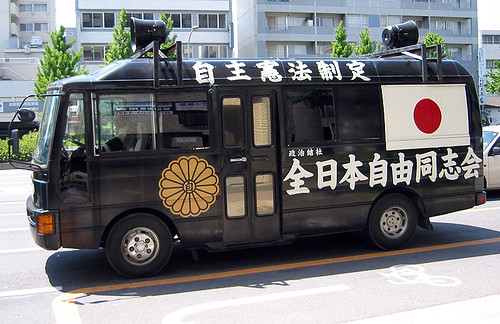First, the story as reported by The Japan Times:
Police arrested four members of a rightwing group Thursday on suspicion of defaming the chief priest of Meiji Shrine last autumn by claiming in loudspeaker truck protests that he had embezzled money.
Toshio Takahashi, 60, head of Kokubo Doshisha (Group to Defend the Country), and group members Kei Sasaki, 69, Shin Sasaki, 34, and Osamu Nakagawa, 33, were arrested on suspicion of slandering the shrine’s chief priest, Katsushi Toyama, 73, police said.
Investigators believe the acts were connected to Meiji Shrine’s erroneous failure to use on invitation cards the appropriate honorific language to describe a visit by Emperor Akihito and Empress Michiko last April.
The shrine, dedicated to Emperor Meiji (1852-1912), used the phrase “ryo denka” (“their highnesses”) instead of “ryo heika” (“their majesties”).
The shrine’s mistake drew criticism from various nationalist groups. A senior member of another group was arrested in February for allegedly breaking windows at Toyama’s home in Setagaya Ward.
According to police, Takahashi and the other three paraded in loudspeaker trucks in the shrine’s vicinity last September and October.
Their speeches featured slanderous claims, including that the chief priest had pocketed income from Meiji Jingu Stadium, investigators said. Between last September and February, the group paraded near the shrine in loudspeaker trucks some 150 times, according to police.
What exactly were the right wingers so upset about? What do these titles even mean?
Meiji Jingu accidentally referred to the Emperor and Empress as ryou-denka. (両殿下) Denka (the prefix simply means ‘both’) in modern usage is a proper way to refer to the princes and princesses of the Imperial family. In earlier times it was also, beginning with the time of the Emperor Daigo (reign 897-930), used to refer to the Fujiwara clan regents who held much of the political power, and eventually by the Shoguns who ran the government during the Muromachi and Edo periods.
The term that the shrine should have used is Ryou-heika (両陛下). Heika is the correct term of address for the Emperor, Empress, the previous Emperor’s wife, or the Imperial Dowager.
According to various Japanese language articles, there was also a second reason for the right-wing protests.
In august of last year, after some sort of quarrel (I haven’t read about the details), the Meiji Shrine withdrew from the Jinja-honchou (神社本庁) in August of last year. It was actually at that time that the right wing groups began their campaign of harassment, which they were ordered to stop by the courts in October. The Jinja-honchou is the nation-wide Shinto organization that was established following the post-war dissolution of state-Shinto. Approximately half of all Shinto shrines in Japan currently belong to the association.
For reference, here is what one of the trucks from one of Japan’s other fascist organizations looks like. Notice the large Japanese flag on the right side, and on the left the chrysanthemum seal of the Imperial Family with the character, 自( short for 自由, meaning ‘freedom’) in the middle. The slogan on top reads ‘Establish an independent constitution,’ which of course means one that does not limit Japan’s military activities, and I would hazard, also isn’t so hung up over protecting the civil rights of Japan’s foreign population.









